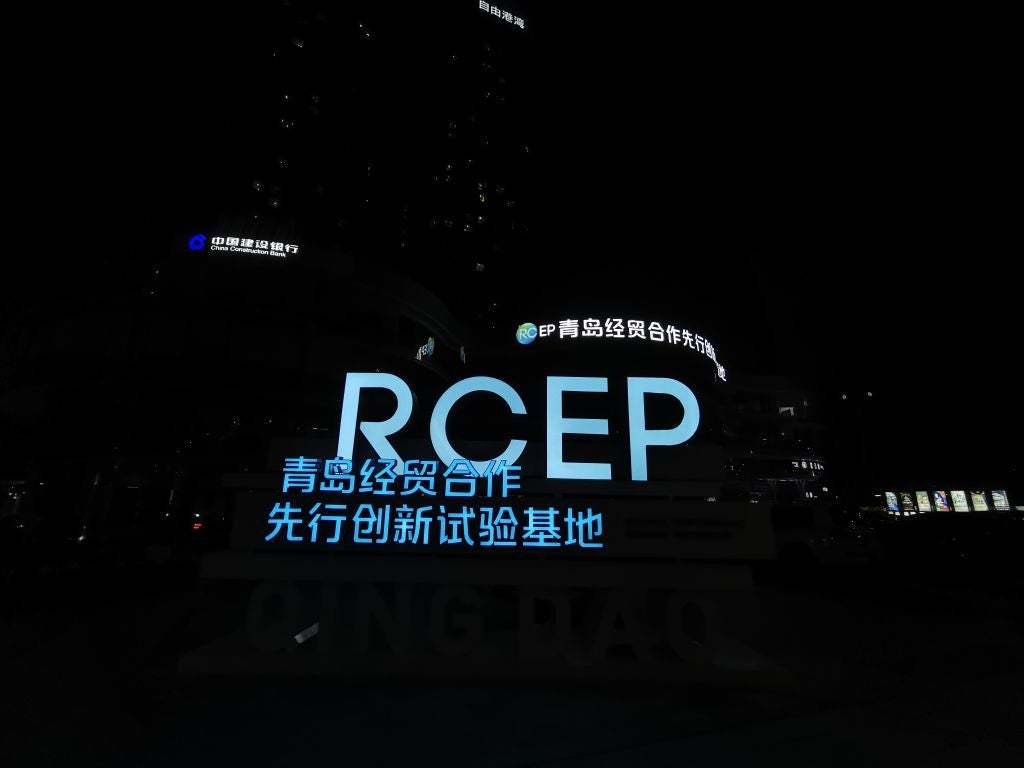
Following a decade of negotiation, 15 Asia-Pacific countries signed one of the biggest trade deals in history as 2020 drew to a close. Known as the RCEP, or the Regional Comprehensive Economic Partnership, it set out to reduce business barriers in an area covering one-third of the world’s population and economic output.
On the first day of 2022, said deal went live, making it officially the world’s largest trading bloc by economic size – representing 30.5% of the world’s GDP, according to a recent UN Conference on Trade and Development (UNCTAD) study. The only other blocs coming close to that are the US-Mexico-Canada agreement (28%) and the EU (17.9%).

Access deeper industry intelligence
Experience unmatched clarity with a single platform that combines unique data, AI, and human expertise.
The RCEP marks a major step forward for economic integration in the Asia-Pacific region, while flying in the face of the global rise of unilateralism and protectionism over the past few years, in ‘the West’ especially.
The agreement eliminates 90% of tariffs among its 15 members and is expected to boost intra-regional exports by $42bn, according to UNCTAD, while other economists have said the deal could add almost $200bn annually to the global economy by 2030. The bloc’s economic size and trade dynamism make it “a centre of gravity for global trade”, summarised UNCTAD’s report.
The economic winners and losers of the RCEP
One of the most striking features of the RCEP is that it brings together countries at very different stages of economic development, from Japan and Singapore to Laos and Cambodia.
The deal took the existing agreements signed by the members of the Association of South East Asian Nations (Asean) – Brunei, Cambodia, Indonesia, Laos, Malaysia, Myanmar, the Philippines, Singapore, Thailand and Vietnam – and combined them into one multilateral pact with Australia, China, Japan, New Zealand and South Korea. The RCEP boasts specific provisions to support its least-developed countries, Laos, Cambodia and Myanmar, which are expected to benefit a lot from the deal.
Proportionately speaking, Indonesia is likely to be one of the countries that benefits the most, given the diversity of its economy, according to Dr Yu Jie, a senior research fellow on China at the think tank Chatham House. Malaysia is another. In absolute terms, however, the bloc’s most advanced economies will gain the most, especially Japan, China and South Korea (in that order) when it comes to trade gains, according to modelling from UNCTAD. These dynamics are likely to be mimicked by foreign direct investment (FDI) trends within the bloc.

US Tariffs are shifting - will you react or anticipate?
Don’t let policy changes catch you off guard. Stay proactive with real-time data and expert analysis.
By GlobalDataBased on data over the past two decades, intra-RCEP greenfield FDI already surpasses the EU as the largest investment area in the world. This is only set to grow since the RCEP allows investors in certain industries to better compete with the local investors, especially manufacturers.
Although the RCEP makes other specific provisions for FDI, especially with regards to intra-RCEP investment conferences and promotion, the deal remains highly focused on trade facilitation, especially physical trade, manufacturing and other more blue collar sectors – industries that unite the bloc’s economically diverse nations – says Yu.
In this regard, one of the deal’s greatest strengths is that it unifies rules of origin for all goods traded between its members. In other words, when a company manufactures a product for the RCEP it works for all 15 countries, meaning much less paperwork. This is one of the best examples of how the pact brings Asia a step closer to becoming a coherent trading zone like the EU or North America. It is also something that makes the region even more attractive for FDI, especially across large parts of the primary and secondary economies.
On the other hand, the RCEP has been described as far more rudimentary and shallow than other ‘megadeals’ – such as the Comprehensive and Progressive Agreement for Trans-Pacific Partnership (CPTPP) – due to its low provisions for services and digital trade, as well as its failure to remove more tariffs on agriculture, automotives and other strategic sectors. From a ‘Western’ perspective, the deal also falls short on ensuring climate change commitments and labour rights protection, says Yu.
Although the RCEP brings together some of the world’s most FDI-restrictive countries, thereby encouraging them to soften their regimes, Yu maintains that “in practice, many of the Asian economies are still very much led by known or unspoken trade and investment barriers due to political circumstances”. For this reason many foreign direct investors might take a wait-and-see approach in the coming year or two.
A big win for Chinese geopolitics
In terms of the negotiation process, Asean holds the glory of having organised and led the mission to realise the RCEP – but in terms of geopolitics, it is China that gains the most, extending its influence across much of Asia-Pacific.
In short, China’s mammoth economy gives it enormous leverage. So, while the RCEP was Asean’s agreement, it will be hard for Asean to stay in command. Meanwhile, the US sits outside the trade bloc, as well as Asia’s next largest trade party, the CPTPP, since former president Donald Trump withdrew the US in 2017. In other words, neither the US or the EU, the world’s traditional trade superpowers, have a voice in Asia’s key trading bodies.
“Another win for China is that RCEP helps it secure its neighbouring market, making it a key part of Beijing’s tilt to the Indo-Pacific, but the deal is also a win in terms of China’s domestic economic reorganisation via the dual circulation strategy: boosting domestic production and consumption,” says Yu. For decades, a China-led Asia has been delivering goods to others, mostly non-Asian markets. The RCEP helps reverse that, boosting regionalisation and localisation.
Beijing will also be clinking glasses at the fact that the RCEP brings the country closer to Australia, Japan and South Korea, countries with whom China has spent years seeking bilateral free trade agreements (amid rising political tension, especially with regards to territorial disputes in the South China Sea). This is the first ever free trade deal between China, Japan and South Korea, thereby accelerating talks for a China-Japan-South Korea-specific free trade agreement in the future. While all of this could embolden China, a negative could be that increased economic integration may actually do the reverse, since China is also now more intertwined with its powerful RCEP neighbours.
In any case, integrating itself with the aforementioned countries will be key to China’s aspirations to join the CPTPP (which already includes Australia, South Korea and Japan); however, fear of Beijing’s geopolitical gains is likely to withhold an easy entry. This is one reason why the UK and the US (depending on Joe Biden’s successor) are likely to try and find a seat at the CPTPP table in the coming years.
For now though, China finds itself in an enviable position that underlines the US’s declining influence in the region. Through the likes of the RCEP and CPTPP, the locomotive of economic integration seems far more party to Asia, not the ‘the West’, the historic pioneer of the free trade agreement. How the tables have turned.







